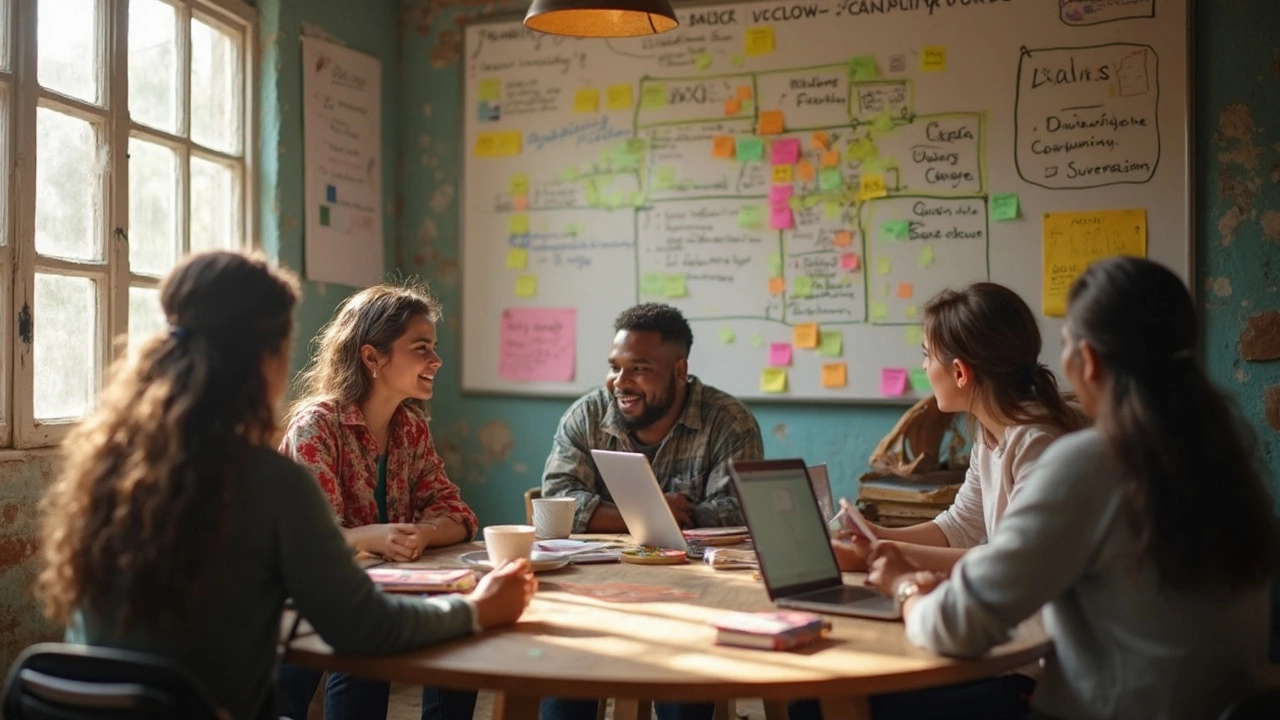Community Outreach Strategy: What It Is and How It Works
 Apr, 24 2025
Apr, 24 2025
Community outreach sounds simple—just get out there and help, right? It’s actually a bit more layered. A solid outreach strategy is all about figuring out who you want to reach, how you want to connect, and why they should care. Without a plan, you’ll waste energy, time, and maybe even your motivation. I’ve seen groups send out flyers hoping for a full house, only to find empty chairs. That’s where a real strategy changes everything.
If you run a local food pantry, let’s say, you can’t rely on word of mouth alone. Maybe the folks who need you most aren’t following your Facebook page or checking community bulletins. You need a plan that meets people where they actually are. That’s the heart of a community outreach strategy: putting your efforts exactly where they count, so every action makes a difference you can see.
- What Makes an Outreach Strategy
- Why Outreach Matters—Beyond Good Intentions
- Building Blocks of a Great Plan
- Real-World Tips For Outreach that Sticks
What Makes an Outreach Strategy
Ever wonder why a community outreach event totally flops while another one draws a full crowd and actual results? It all comes down to having a real strategy. A strategy is basically your game plan. It covers who you want to reach, what you’ll actually do, and how you’ll know if it’s working. Without these basics, even the best intentions won’t get far.
The first piece is clear goals. You can’t just say, “We want to help.” Be specific. Do you want to increase turnout at a local clinic by 20%? Get 100 new volunteers this year? Specific goals make results measurable, so you’re not just guessing if it worked.
Second, know your audience. Are you trying to connect with seniors, parents, teens, or maybe new immigrants? Each group has its own habits and hangouts. If your outreach strategy uses flyers for teens, don’t be shocked if no one shows up. Go where your audience already is—whether it’s Instagram, school events, or local markets.
Here’s what goes into a solid community outreach strategy:
- Identifying your goals: Figure out what you want to achieve. More awareness? More donations? Build partnerships?
- Mapping out your audience: Get specific. Details like age, language, and what they care about matter a lot.
- Choosing the right method: Decide how you’ll reach people, like social media, workshops, knocking on doors, or local radio.
- Tracking what works: Use checklists, feedback, or even spreadsheets to track progress. Don’t just guess; use real numbers.
For example, a 2023 survey by VolunteerMatch found organizations with a written outreach plan were 27% more likely to see sustained volunteer engagement compared to those just winging it. That’s proof a clear outreach strategy makes a difference.
Good plans are specific, flexible, and focused on real people—not what sounds trendy. They make sure your energy goes into actions that get results, not just activities that look good on Instagram.
Why Outreach Matters—Beyond Good Intentions
Having good intentions is great, but if your community outreach stops there, you’ll hit a wall fast. Real outreach is about building trust, creating real change, and making people feel seen and heard. In fact, studies from the National Council of Nonprofits show that organizations with a clear outreach strategy see up to 50% higher participation rates than groups that wing it. Intentions set the baseline, but strategy gets you results.
You can have the best ideas or programs, but if people don't know about them, nothing happens. Think about a free health clinic that never gets patients or a reading program with only two kids showing up. Outreach fills that gap by meeting people where they already are—whether it's at local schools, faith centers, or social media. And when these connections work, new voices, needs, and ideas can make your projects even better.
Effective community engagement often leads to:
- Increased awareness for vital services (like food drives or after-school help)
- Better trust between organizations and their neighborhoods
- Higher volunteer and donor support
- Feedback that actually shapes what you do next
Data backs this up. Here’s a quick look at the impact of proper outreach versus zero strategy:
| With Outreach Strategy | No Outreach Strategy |
|---|---|
| Average event attendance: 70% | Average event attendance: 28% |
| Volunteer retention: 8+ months | Volunteer retention: 3 months |
| Community satisfaction: 80%+ | Community satisfaction: 45% |
Guess what? People can tell when your efforts are genuine versus when they're just for show. So, for local programs and nonprofit tips to land right, you need a real relationship—not just a mailer or a single event. That's why strategy beats good vibes every time.

Building Blocks of a Great Plan
If you want your community outreach efforts to stick, you need a plan that covers all the bases—no guesswork. It’s not about fancy presentations; it’s about details that work every day.
Solid outreach strategy always starts with knowing exactly who you want to reach. Are you focusing on families with young kids, seniors living alone, or recent immigrants? The better you understand your target group, the easier it is to get their attention. Some local surveys say that over 60% of outreach projects miss their mark because they don’t really clarify who they’re trying to serve.
The next big thing is messaging. You have to talk about what matters to your audience, not just what you think is important. For example, if you’re running a community engagement workshop for teens, forget wordy flyers—head straight to Instagram, TikTok, or the cafeteria during school lunch breaks.
Here’s a quick hit-list of what every great plan should have:
- Clear goals: Are you trying to spread information, get volunteers, or gather feedback? Name your top priorities so you can measure progress.
- Target audience: Get specific—age, location, interests, habits. Create a simple profile for who you most want to reach.
- Key messages: Boil down what you want to say into short, catchy points anyone can understand.
- Best channels: Don’t waste time on platforms your crowd ignores. Figure out if text alerts, door knocking, social media, or local radio reaches them fastest.
- Timeline: Map out what needs to happen and by when. Hustle matters—so do deadlines!
- Ways to measure success: Check if people show up, sign up, or spread the word. Did you hit your goal or fall short? Plan to adjust as you go.
If it helps, here’s what some groups use to keep things moving:
| Key Element | Questions to Ask |
|---|---|
| Audience | Who exactly are we targeting? Where do they spend time? |
| Message | What are their top concerns? How can we address them in plain language? |
| Channels | Which platforms, places, or people can connect us? |
| Feedback | How can we check if our approach is actually working? |
The most effective community outreach happens when you keep things practical. Start small, keep it real, review what works, and then level up only when you see actual impact. Trust me, it saves a lot of headaches later.
Real-World Tips For Outreach that Sticks
There’s a big gap between just handing out flyers and actually building trust in your community. A community outreach strategy that sticks comes down to actions that people remember—stuff that actually makes a difference for them. Here are some clear, hands-on tips that have worked for real organizations:
- Meet people in their own spaces. Think local bus stops, grocery store parking lots, community centers, churches, barber shops. The United Way found that pop-up info tables at laundry mats drew in three times more parents than at nearby schools. People go where they’re comfortable.
- Partner up for credibility. Not everyone knows your group, but they recognize the school down the block or their favorite local clinic. Team up for events and you’ll instantly get borrowed trust. Reach out to local businesses—they’re often eager for visibility and want to look good supporting the community.
- Speak their language—literally. If your neighborhood is 40% Spanish-speaking, but every handout is in English, you’ve lost nearly half your audience. Clear, friendly language matters even more. No jargon, no official-sounding “outreach speak.” Just talk like a real person.
- Use simple tech solutions. You don’t have to chase TikTok trends. Something as basic as WhatsApp group chats can drive way more engagement than social media posts. Small nonprofits using SMS reminders saw a 20% higher attendance at events, according to a CivicPlus survey in 2023.
- Show your impact quickly. When people see real results, even tiny ones, it hooks their interest. Snap before-and-after photos, share testimonials at events, or post little wins on a corkboard where everyone hangs out. Don’t rely on annual reports—share wins in real time.
To make things clearer, check out how the numbers stack up for outreach effectiveness:
| Strategy | Event Attendance Boost |
|---|---|
| In-person at local hubs | +30% |
| Partnering with trusted groups | +25% |
| Text message reminders | +20% |
Little tweaks to your approach can transform your whole outreach game. Keep it personal, practical, and genuinely responsive to what the community wants—not what you think they should want. The best community engagement happens when you listen more than talk, and follow up more than you broadcast.